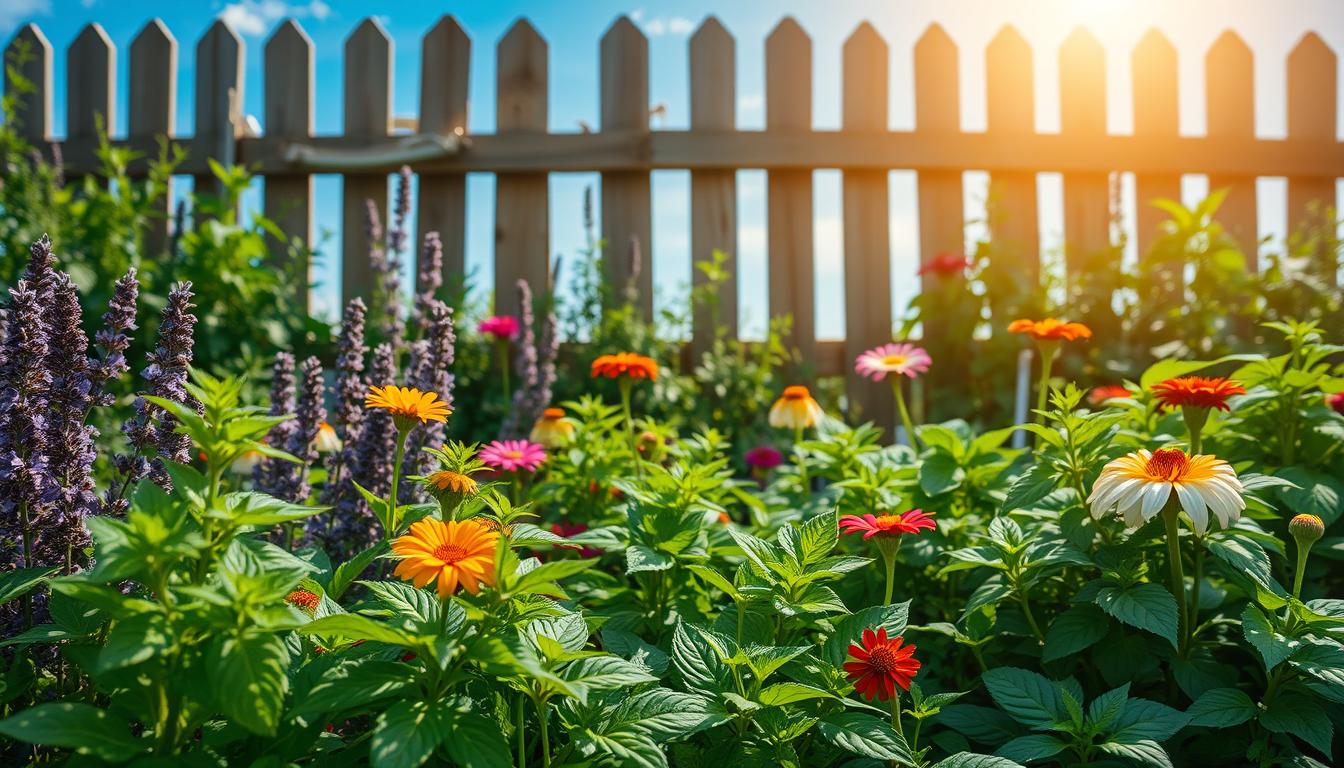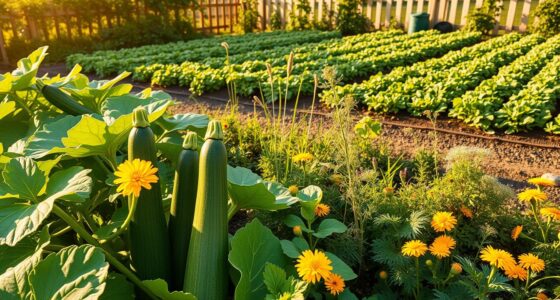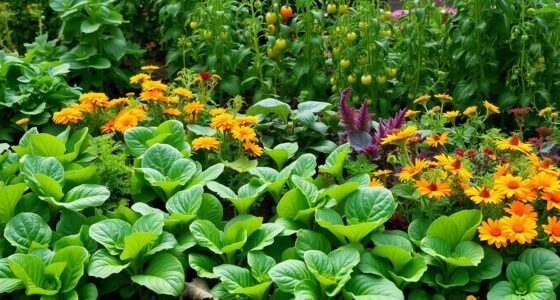Have you ever stepped into your garden, only to be enveloped by the invigorating aroma of mint? There’s something incredibly satisfying about watching this vibrant herb thrive, especially when it’s surrounded by other plants that enhance its growth. As you explore the world of companion planting for mint, you may find that discovering the best plants to grow with mint not only elevates your garden’s health and productivity but also enriches your culinary experiences. Imagine the joy of harvesting mint alongside other complementary herbs and vegetables, each playing its role in creating a lush and bountiful oasis that reflects your personal touch. In this article, we will delve into the diverse mint companion plants that can transform your garden into a flourishing sanctuary.
Key Takeaways
- Mint thrives best with compatible companion plants that enhance its growth.
- Understanding the unique characteristics of mint is crucial for successful gardening.
- Companion planting for mint can improve health and productivity in your garden.
- Choosing the right mix of plants can lead to richer flavor profiles in your cooking.
- Take advantage of the pest deterrent properties of specific plants when pairing with mint.
Understanding Mint and Its Growth Habits
Mint is a versatile and aromatic herb, making it a popular choice for gardeners and culinary enthusiasts alike. You will find that the unique characteristics of mint include its vigorous growth and fragrant leaves, which not only delight the senses but also provide health benefits. Knowing how to nurture this herb will enhance your gardening experience.
What Makes Mint Unique?
The unique characteristics of mint stem from its essential oils, which serve various purposes. These oils contribute to mint’s signature flavor and aroma while acting as a natural pest deterrent. This means that growing mint in your garden can help protect neighboring plants from insects and pests. Mint varieties, such as spearmint and peppermint, can vary in flavor and usability, giving you room to experiment in both the garden and kitchen.
Growth Conditions for Mint
To successfully cultivate mint, you should understand its mint growth habits and preferred growing conditions for mint. This herb thrives in moist, well-drained soil. Ideally, you want to place it where it can bask in full sun to partial shade, making it adaptable to various garden settings. Regular watering is crucial, as mint enjoys consistent moisture. By providing the right environment, you will enjoy abundant yields and flavorful leaves throughout the growing season.

| Mint Growth Habits | Optimal Conditions |
|---|---|
| Vigorous growth | Moist, well-drained soil |
| Spreads rapidly | Full sun to partial shade |
| Preferred moisture | Regular watering |
| Variety in flavors | Adaptable to garden settings |
Why Companion Planting Matters
Companion planting for mint not only benefits the mint itself but also creates a thriving garden environment. This practice allows different plant species to grow together, resulting in healthier plants and improved yields. Through this method, you can enjoy the many advantages that well-chosen companions provide.
Benefits of Companion Plants for Mint
The benefits of companion plants significantly impact mint’s health. Certain plants can repel pests, which is essential for maintaining the mint’s vibrant foliage. Others may improve nutrient availability in the soil, contributing to overall plant health. Additionally, companion plants can create a barrier against harsh weather, creating a more suitable growing environment.
How Companion Plants Enhance Growth
Enhancing growth through companion planting works through various interactions. Plants that grow well with mint can boost its essential oil production, which contributes to stronger flavors and aromas. Some companions foster a healthier ecosystem by attracting beneficial insects that help pollinate mint and other plants. Over time, these practices build a robust and diversified garden, maximizing the output of each growing season.

| Companion Plant | Benefit | Enhancement Effect |
|---|---|---|
| Basil | Repels pests | Boosts flavor |
| Marigolds | Deterrent for nematodes | Promotes growth |
| Chives | Protects against aphids | Increases vigor |
Best Companion Plants for Mint
When cultivating mint, selecting the right companions can significantly enhance its growth and flavor. Understanding the best companion plants for mint will ensure a thriving garden and vibrant flavors. Among the top choices are basil, rosemary, and marigolds. Each of these plants brings unique benefits, making them superb partners for mint.
Basil: A Perfect Pairing
Basil and mint pairing creates a harmonious relationship in the garden. Both plants enjoy similar growing conditions, thriving in well-drained soil and receiving ample sunlight. The aromatic profile of basil beautifully complements mint, enhancing your culinary dishes. Planting them together encourages robust growth, allowing both herbs to flourish while enriching the flavors of your meals.
Rosemary: Enhancing Flavor
Rosemary benefits for mint extend beyond flavor enhancement. This hardy herb not only adds a delightful taste to various dishes but also helps repel pests with its strong aroma. Keeping pests at bay allows mint to grow healthier and more robust. When planted alongside rosemary, mint can focus on thriving instead of fighting off unwanted visitors, resulting in a more fruitful harvest.
Marigolds: Pest Deterrent
Integrating marigolds into your garden is a smart strategy for pest control. These vibrant flowers deter nematodes and other harmful insects, creating a safer environment for mint and its neighboring plants. By including marigolds as companions, you contribute to a healthy ecosystem that supports mint’s growth without the need for chemical pesticides. This approach allows your mint plant to thrive while keeping your garden naturally beautiful.
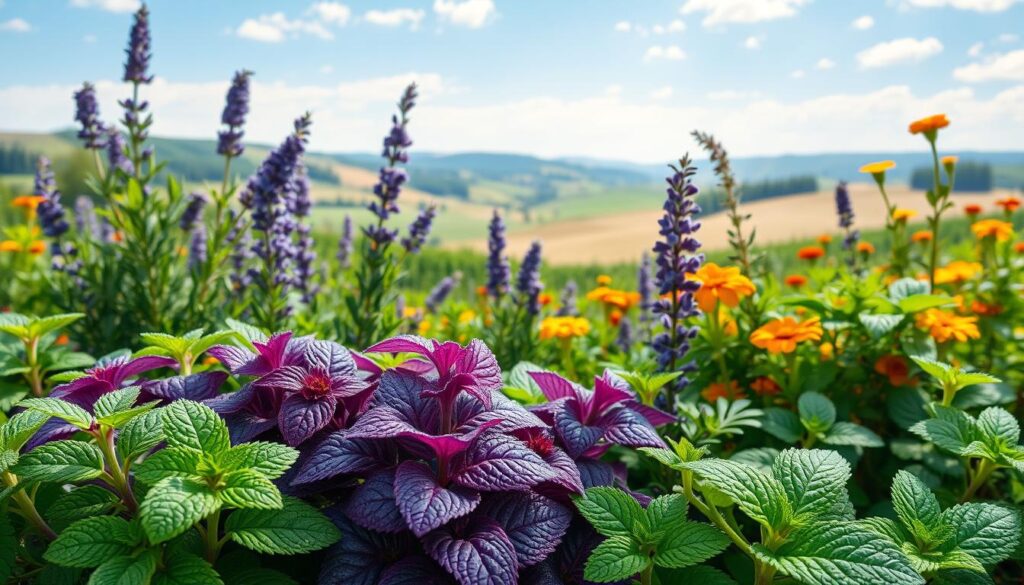
Ideal Vegetables to Grow with Mint
When you think about pairing vegetables with mint, you’ll discover a few standout options that really complement each other. These combinations not only enhance flavors in your garden but also provide pest protection and encourage healthy growth. Let’s explore the best vegetables to grow with mint and why they work so well together.
Peas: A Healthy Match
One of the best examples of mint and pea compatibility lies in their mutual benefits in the garden. Mint acts as a natural deterrent for aphids, which can harm pea plants. By growing these two together, you help protect your peas while enjoying the aromatic qualities that mint brings. Enjoying fresh peas with mint creates a refreshing addition to your meals!
Tomatoes: Flavor Amplifiers
Another fantastic option for tomatoes and mint planting is their shared environment in your veggie patch. Mint not only enhances the flavor of tomatoes, but it also repels harmful pests that may invade your tomato plants. By incorporating these two plants, you create a thriving duo that elevates taste and captures the essence of a summer garden.
Carrots: A Rooty Relationship
Carrots grow well near mint, benefiting from its ability to deter pests like carrot flies. This productive pair serves as a practical combination for any gardener looking to maximize the health of their crops. When you plant carrots alongside mint, you safeguard your harvest while enjoying the distinct flavors they both bring to your kitchen.
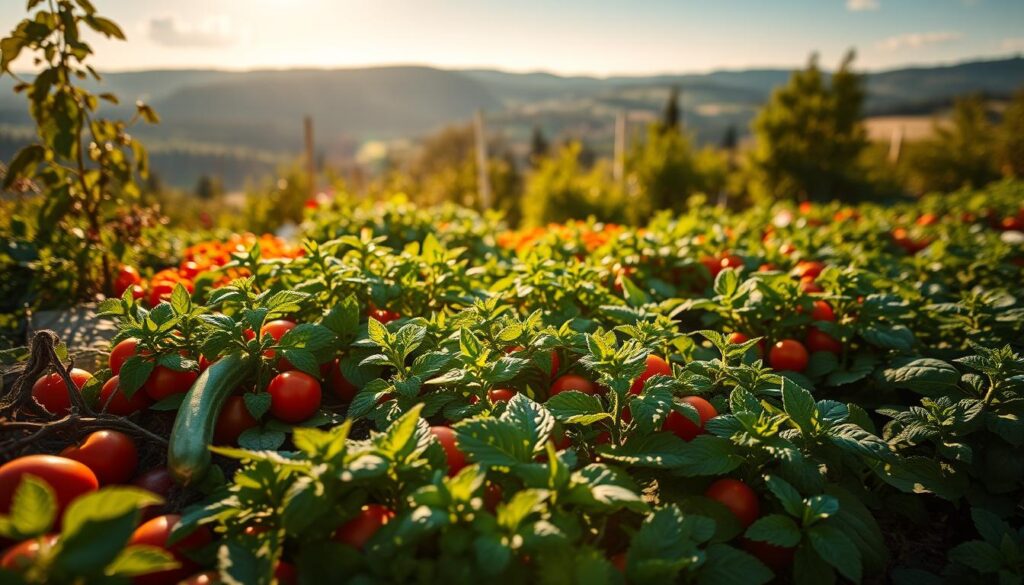
Flower Companions for Mint
When growing mint, incorporating flower companions can greatly enhance both your garden’s beauty and its health. Two notable flowers that coexist well with mint are chives and nasturtiums. These plants not only bring vibrant colors but also offer specific benefits that support the growth of mint.
Chives: An Attractive Ally
Chives and mint share a mutually beneficial relationship, showcasing a delightful example of chives and mint friendship. The vibrant purple blossoms of chives stand out in any garden setting. They offer an aesthetic appeal while acting as a natural deterrent for aphids, which can harm mint plants. This dual-purpose functionality makes chives an exceptional choice for your mint garden.
Nasturtiums: Edible Garden Brighteners
Nasturtiums bring a splash of color and flavor to your garden, providing numerous nasturtiums benefits. These flowers not only attract beneficial insects that promote pollination but also help repel pests that could threaten your mint. Additionally, the edible flowers of nasturtiums can elevate the taste of dishes featuring mint, creating a wonderful synergy in your culinary adventures.
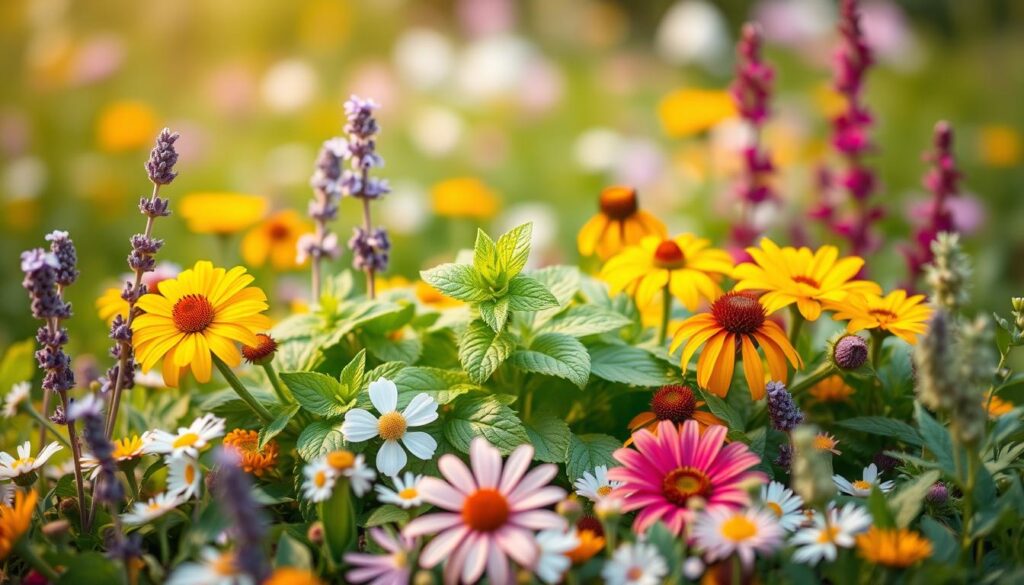
Herbs That Thrive Alongside Mint
Creating a thriving herb garden not only relies on choosing the right herbs but also understanding their relationships with one another. When considering herbs that grow well with mint, two stand out as exceptional companions: oregano and cilantro. Each offers unique benefits that enhance their growth when planted alongside mint.
Oregano: Complementing Flavors
Oregano companionship with mint brings out the best flavors in both herbs. Oregano thrives in similar conditions as mint, preferring full sun and well-draining soil. The robust flavor of oregano wonderfully complements the refreshing taste of mint, making them ideal partners in culinary dishes. Additionally, planting oregano near mint helps to deter specific pests that might harm your mint plants.
Cilantro: A Flavorful Duo
Mint and cilantro benefits extend beyond their shared growing conditions. Cilantro attracts beneficial insects, which help pollinate flowers and control pest populations in the garden. Both herbs require similar moisture levels, making them suitable to grow together. This partnership not only enhances flavor but also promotes an ecological balance in your herb garden.
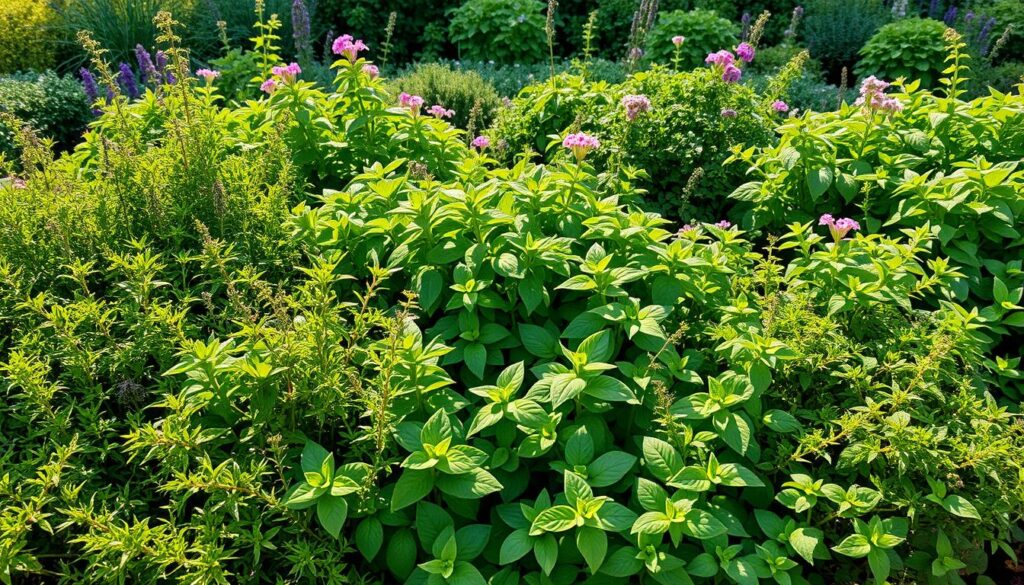
| Herb | Light Requirements | Water Needs | Benefits |
|---|---|---|---|
| Oregano | Full Sun | Moderate | Complements mint flavor, deters pests |
| Cilantro | Full Sun to Partial Shade | Moderate | Attracts beneficial insects, enhances ecological balance |
Mint and Pollinator-Friendly Plants
Incorporating mint and pollinator plants into your garden not only enhances its aesthetic but also fosters a thriving ecosystem. Two excellent companions for mint are bee balm and lavender. These plants attract essential pollinators like bees, enriching both the garden’s biodiversity and providing a myriad of benefits for your mint.
Bee Balm: Attracting Bees
Bee balm is renowned for its vibrant blooms and ability to draw in bees and other beneficial insects. The bee balm growing benefits extend beyond making your garden visually appealing. It helps increase pollination rates, ensuring that your mint produces abundantly. Additionally, bee balm improves the overall health of your garden by creating a balanced ecosystem that supports various pollinators.
Lavender: A Buzzing Benefit
Lavender offers multiple advantages when planted alongside mint. With its fragrant blooms, lavender aids in repelling pests, making it a natural companion to mint. The compatibility of lavender and mint not only enhances the overall fragrance of your garden but also supports the health of your mint plants, resulting in flavorful leaves that you can enjoy. Combining these plants creates a delightful sensory experience while benefiting your entire garden.

| Plant | Pollinator Attraction | Growth Benefits |
|---|---|---|
| Bee Balm | Highly attracts bees and butterflies | Enhances pollination, improves biodiversity |
| Lavender | Attracts various pollinators | Repels pests, enhances mint flavor |
Managing Mint’s Spreading Habit
Mint is notorious for its aggressive growth, which can sometimes overwhelm your garden. To maintain a harmonious gardening ecosystem, you can adopt various mint containment strategies. Utilizing companion plants and planting mint in containers are two effective methods that not only control its spread but also promote a vibrant garden.
Containing Mint with Companion Planting
Companion planting offers a natural barrier to curb the expansive roots of mint. By choosing specific plants that thrive in proximity to mint, you restrict its growth while enhancing your garden’s biodiversity. Here are a few companion plants that work well:
- Thyme
- Catnip
- Lavender
These plants not only limit mint’s spread but also attract beneficial insects. Regularly observe your garden to ensure the balance of these plants promotes healthy growth for all your companions.
Using Containers for Control
Another practical approach is managing mint growth by placing it in containers. This method prevents mint’s vigorous roots from invading your garden. When selecting containers, consider the following:
- Ensure ample drainage holes.
- Choose a size that allows for healthy growth.
- Use quality potting soil for optimal nutrition.
With mint in containers, you gain more control over its development, making it easier to enjoy its flavor in culinary dishes without overwhelming your other plants. Implementing these mint containment strategies will contribute to a thriving garden environment.
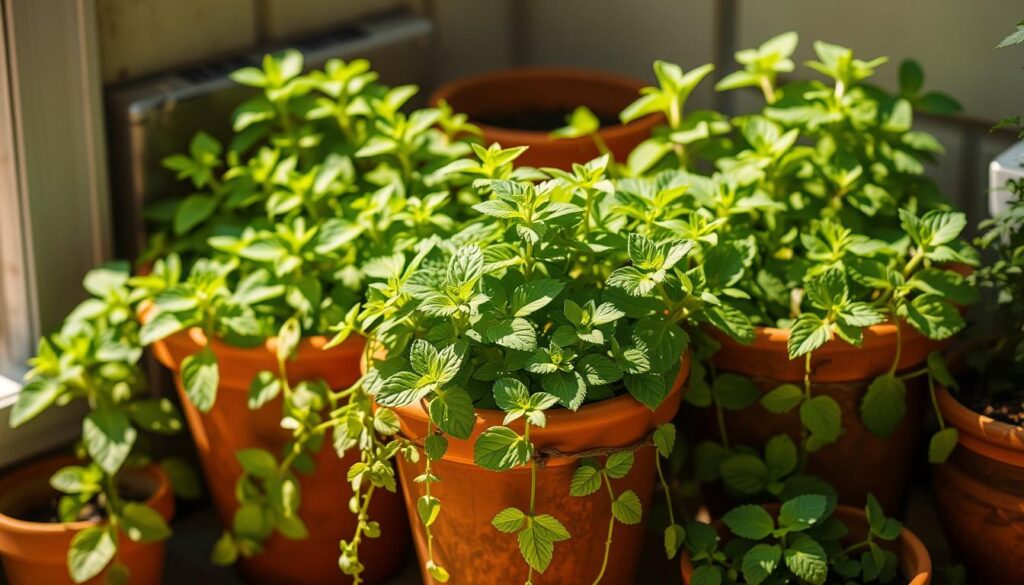
Seasonal Considerations for Mint and Companions
Understanding the seasonal needs of mint and its companions will enhance your gardening efforts. Seasonal planting with mint requires attention to the various climates and conditions each time of year presents. In summer, selecting the right companion plants can optimize growth and yield, while fall planting for mint focuses on hardier options that endure the cooler temperatures.
Summer Pairings
During the summer months, mint thrives alongside heat-tolerant plants. These summer companion plants complement the mint’s vigor and suppress pests effectively. Consider these options:
- Basil
- Marigolds
- Peppers
These plants support mint’s growth while providing beneficial effects on soil health and pest control.
Fall Companions
As the temperatures cool, fall planting for mint becomes crucial. This is the perfect time to introduce hardier vegetables that can withstand cooler weather, such as:
- Brussels sprouts
- Root vegetables
- Winter squash
Implementing these practices ensures your garden remains productive throughout the changing seasons.

Tips for Planting Mint with Others
Successfully planting mint alongside other plants involves careful consideration of spacing and soil conditions. By adhering to certain guidelines, you can create a vibrant garden that promotes growth and health for all your plants, especially mint.
Spacing and Layout
Optimal spacing for companion planting is essential for preventing overcrowding and ensuring each plant has room to flourish. When planting mint, give at least 18 inches of space between each mint plant and its companions. This distance allows for adequate airflow and prevents competition for nutrients.
- Plan your layout to incorporate taller plants behind mint, ensuring they do not cast shade.
- Consider a staggered arrangement to maximize light exposure.
- Use markers to differentiate between mint varieties and companion plants for easy management.
Soil Considerations
The right soil for mint plants plays a crucial role in their growth. Mint thrives in rich, well-draining soil that retains moisture without becoming overly saturated. Aim for a pH level around 6.0 to 7.0 to provide optimal conditions.
- Incorporate organic matter, such as compost, to enrich the soil.
- Regularly check for drainage issues to prevent root rot.
- Conduct a soil test to assess nutrient levels before planting.

Companion Planting Mistakes to Avoid
When it comes to companion planting, a few common mistakes can hinder your gardening success. Being aware of these pitfalls can help you create a thriving mint ecosystem while preventing potential issues that may arise with incompatible plants for mint.
Incompatibility Issues
Choosing the right companions for mint is crucial. Some plants do not thrive alongside it, leading to stress and poor growth. Examples of incompatible plants for mint include:
- Strawberries
- Tomatoes
- Fennel
- Carrots
These plants may compete for resources or react negatively to mint’s strong aroma. Understanding which plants can coexist with mint aids in avoiding these mistakes in companion planting.
Overcrowding Problems
Overcrowding is another aspect to watch out for in your garden. Planting mint too closely with other species can lead to:
- Reduced air circulation
- Increased pest issues
- Competition for nutrients
To optimize space and health, consider overcrowding garden tips such as planting mint in designated areas or using containers. This approach will allow your plants to flourish without competition or compromise.

Harvesting Mint and Its Companions
Harvesting mint at the right time can significantly enhance its flavor. Regular trimming not only keeps the plant healthy but also encourages bushier growth. Equally important is recognizing the best practices for companion plants, as their timing for harvest plays a crucial role in preserving peak freshness and taste.

Best Practices for Mint
When it comes to harvesting mint, timing mint harvest is essential. You should begin your harvest in the morning after the dew has dried but before the sun hits its peak. This timing leads to maximum essential oil content, making your mint more aromatic and flavorful. Use scissors or garden shears to cut the stems, ensuring you leave at least one-third of the plant intact for regrowth.
Timing for Companion Plants
Your companion plants also have optimal harvest times. For instance, basil should be harvested just before it flowers for the best taste, while marigolds provide not only beauty but can also be cut for culinary uses. Aligning the timing of your mint with that of its companions can significantly boost your overall garden productivity.
By implementing these strategies, you ensure a robust yield of both mint and its companion plants, contributing to a thriving garden ecosystem.
Creative Ways to Use Mint and Its Companions
There are many exciting uses for mint that can elevate your culinary creations and improve your well-being. Mint in cooking shines in numerous dishes, beverages, and desserts. Beyond its flavor, consider the herbal benefits of companions that thrive alongside mint. Combining these herbs can enhance not only taste but also offer greater health advantages.
Culinary Uses
Mint serves as an aromatic addition to various recipes. Its fresh, invigorating flavor complements salads and dressings beautifully. You might find mint transforming a simple fruit salad into a refreshing dessert. Consider using mint in beverages; a sprig of this herb can elevate your iced tea or lemonade to a whole new level. Pairing mint with companions like basil or cilantro can create unique flavor profiles that surprise and delight.
Herbal Remedies
Beyond the kitchen, the herbal benefits of companions can enhance your health. For example, rosemary can improve cognitive functions while mint aids digestion. Combining these herbs in teas or infusions can provide soothing effects. Try a mint and chamomile blend for relaxation or use oregano for its immune-boosting properties. Emphasizing the potentials of these herbs can enrich your life, making your garden an oasis of healthful ingredients.

Seasonal Care Tips for Mint Plants
Caring for mint plants involves adapting your strategy according to the seasonal changes. Each season presents unique challenges and opportunities for your mint’s health and growth. Understanding the distinct needs during winter and spring can significantly improve your mint cultivation experience.
Winter Care
Winter mint care is crucial for maintaining the vitality of your mint plants. During the colder months, mint can succumb to freezing temperatures and harsh weather conditions. Consider these methods to protect your plants:
- Cover mint plants with a frost cloth to shield them from extreme cold.
- If your mint is in pots, move the containers to a more sheltered location, such as a garage or covered patio.
- Water the plants sparingly, as mint requires less moisture during winter.
Spring Planting
Planting mint in spring signals a rejuvenation period. As temperatures warm, mint becomes more active and requires attention to ensure strong growth. Follow these guidelines to promote healthy mint development:
- Choose a well-draining soil to facilitate root growth and minimize the risk of rot.
- Ensure full sun exposure for at least six hours a day to encourage robust foliage.
- Consider dividing and replanting established mint plants to create more space and stimulate growth.
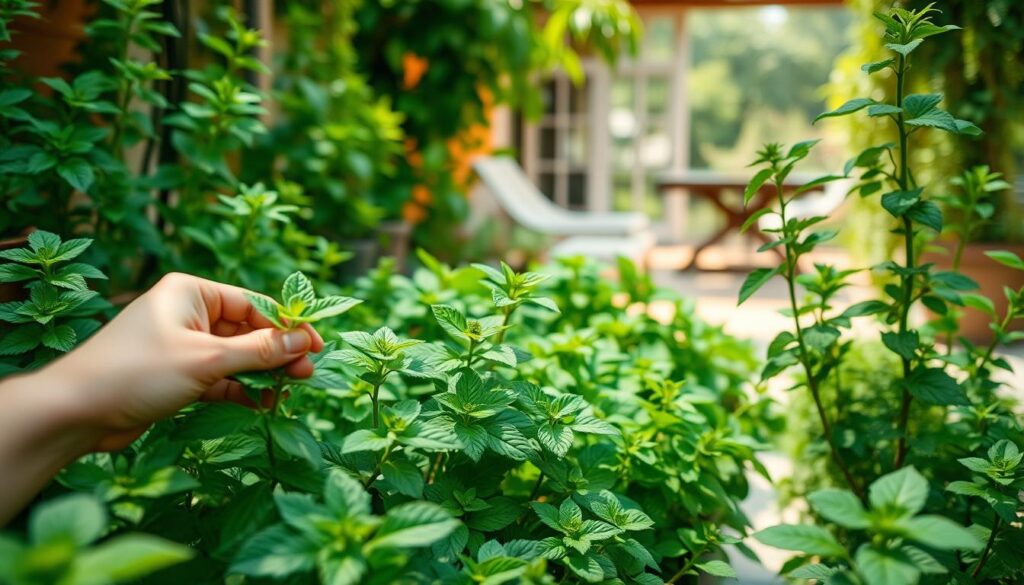
By attentively providing winter mint care and strategically engaging in planting mint in spring, you can cultivate thriving mint plants ready to add flavor to your dishes and transform your garden into a lush oasis.
Conclusion: Creating Your Mint Oasis
As you wrap up your journey into the enchanting world of mint companion plants, consider the importance of crafting your personalized companion plan. Creating a mint garden tailored to your preferences can significantly enhance the growth and flavors of your plants. By carefully selecting compatible companions such as basil, tomatoes, or even marigolds, you can cultivate a harmonious ecosystem that not only boosts flavor profiles but also creates an aesthetically pleasing environment.
Embrace the numerous benefits of a mint oasis, from the delightful culinary uses to the therapeutic properties of your fresh herbs. Imagine incorporating mint into your favorite recipes or whipping up soothing herbal remedies. Your labor will be rewarded as you relish the often-overlooked joy that comes from growing mint and its companions within your own garden.
With a little planning and care, your mint garden can evolve into a vibrant sanctuary bursting with flavor and fragrances. So, dive in, experiment, and enjoy the fruits of your labor as your garden flourishes and brings you culinary delights and healing benefits for seasons to come.
